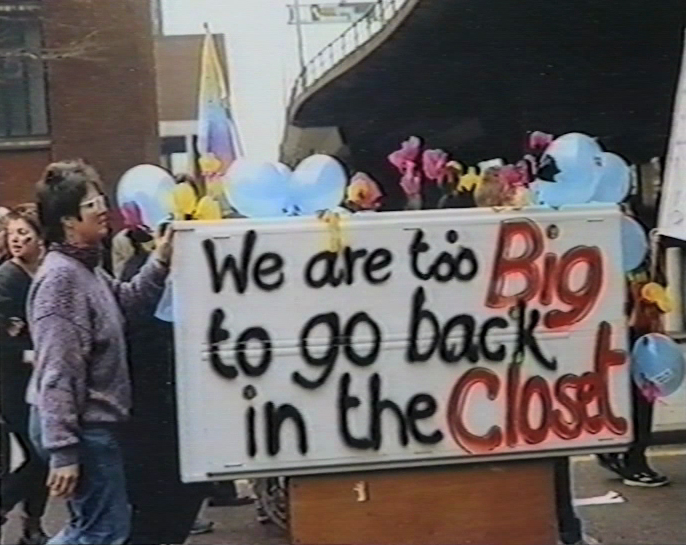Video 28 (Vera Productions, 1998, UK, 22 min, Digital) from the Cinenova will be screened as part of this important event taking place at Ryerson University, Toronto, Canada.
2016 marked thirty years since a UK Local Government Act to “refrain local authorities from promoting homosexuality” was tabled by Lord Halsbury in the House of Lords. Two years later this became Clause 28 or Section 28. This screening focuses on the importance of media interventions, campaign tapes and artist videos made by lesbian and gay activists in the UK in response to the law.
These videos foreground issues of visibility and misrepresentation that were central to lesbian and gay media activism at the time. Inquiring about the legacy of Section 28 and the activism surrounding it, this programme will be disrupted by short video experiments that are the outcome of an ongoing video project We have rather been invaded, which was initiated by Ed Webb-Ingall and explores the impact and legacy of Section 28 through a series of participatory activities.
PROGRAM:
VIDEO 28 (Vera Productions, 1998, UK, 22 min, Digital)
What’s So Great about Being Straight? (“Out on Tuesday”, Channel 4, 1989, UK, 1 min, Digital)
Pedagogue (Neil Bartlett and Stuart Marshall, 1988, UK, 10 min, Digital)
Kiss 25 Goodbye (Steve Farrer, 1991, UK, 7 min, Digital)
The programme will be disrupted by short video experiments that have been made by the We have rather been invaded group in 2016 and 2017.
Followed by a discussion about video activism and queer legacies with Ed Webb-Ingall, artist Sharlene Bamboat, and scholar and curator Cait McKinney
WHEN & WHERE:
Tuesday 4 April
Doors: 6:30pm
Screening and Discussion: 7:00pm
FREE
Image Arts Building (IMA 307), Ryerson University
https://
BIOS
Ed Webb-Ingall is a writer and filmmaker; he is a PhD candidate at Royal Holloway University, London, where his research focuses on the history and practice of community video in the UK. He currently runs the public programme for the London Community Video Archive, at Goldsmiths University. Between 2014 and 2016 he carried out a community video project at The Showroom, London and in 2016 he was commissioned by Studio Voltaire, London to develop a video that looked at the legacy of Section 28. He regularly runs workshops and seminars on experimental filmmaking and artist moving image
Sharlene Bamboat is an artist working predominantly in film, video and performance. Her work uses humour to explore the relationship between memory and desire animating histories of South Asian diasporas and national belongings. Recent exhibitions and screenings include Les Complices* (Zurich), the Images Festival (Toronto), Art Gallery of Windsor (Canada) and Vasakh Film Festival (Lahore).
Bamboat often works collaboratively, most notably with artist Alexis Mitchell under the name Bambitchell. In 2016 the duo were artists-in-residence at Akademie Schloss Solitude in Germany. Bamboat inhabits various roles in the Canadian cultural sector – advisory committee for the 37th Rhubarb Festival (2016), board member at Pleasure Dome Experimental Film and Video Collective (2011-2015), Artistic Director at SAVAC (South Asian Visual Arts Centre 2011-2015), jury member for Inside Out LGBT Film Festival (2012). She is part of an upcoming group show at the Aga Khan Museum in Toronto (July 2017).
Cait McKinney researches the digital media histories of queer and feminist social movements. Recent writing appears in Feminist Theory, the Radical History Review, and Drain: Journal of Contemporary Art and Culture. Cait is postdoctoral fellow at the LGBTQ Oral History Digital Collaboratory, based out of the University of Toronto, and teaches in the Faculty of Information and Media Studies at Western University.
ABOUT VERTICAL FEATURES:
Vertical Features takes its name from Peter Greenaway’s 1978 featurette Vertical Features Remake. A fictional documentary that also borrows from the language of structural film, Greenaway’s experiment serves to trouble claims of authenticity and authorship, issues still relevant in the world of documentary and other non-fiction media, especially as it moves online and into the gallery.
The name Vertical Features serves to evoke the idea of work that exists adjacent—even perpendicular—to conventional cinema, works that risk oversight. The series hopes to promote vital non-fiction film and video that has had little or no Toronto exposure, including documentary, essay films, hybrid experiments, and artists’ moving image, placing contemporary films in dialogue with historical rediscoveries. Supplemented by introductions and discussions with guest scholars, artists, and critics, Vertical Features serves to highlight and situate these exceptional works.
